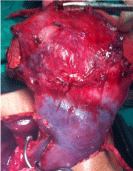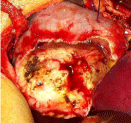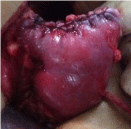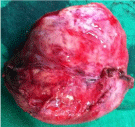Research Article
Long Term Follow-Up in Children Undergoing Nephron Sparing Surgery for Non-Syndromic Unilateral Wilms Tumor
Rajendra Nerli1*, Ranjeet Patil1, Shridhar Ghagane2 and Murigendra B Hiremath2
1Department of Urology, KLE Kidney Foundation, India
2Department of Biotechnology and Microbiology, Karnatak University, India
*Corresponding author: Rajendra Nerli, Department of Urology, KLE Kidney Foundation, India
Published: 03 Apr, 2017
Cite this article as: Nerli R, Patil R, Ghagane S, Hiremath
MB. Long Term Follow-Up in Children
Undergoing Nephron Sparing Surgery
for Non-Syndromic Unilateral Wilms
Tumor. Clin Oncol. 2017; 2: 1259.
Abstract
Introduction: Wilms Tumor (WT) represents approximately six to seven percent of all pediatric
cancers and accounts for more than 95 percent of all tumors of the kidney in the pediatric age
group. Recently some centers have explored the role of nephron sparing procedures in children
with unilateral wilms tumors because of the concern about late occurrence of renal dysfunction after
unilateral nephrectomy. We assessed the long term renal functional outcome after parenchymalsparing
procedure for non-syndromic unilateral wilms tumor at our center.
Materials and Methods: We retrospectively reviewed the records of all children with unilateral
Wilms tumor who had undergone nephron sparing surgery at our center. Patient’s long-term renal
function, tumor recurrence, and survival, were determined from a review of each patient’s medical
record.
Results: A total of eight patients underwent Partial Nephrectomy (PN) and the remaining three
with polar tumors underwent Hemi-Nephrectomy (HN) following chemotherapy. Smaller tumor
volumes were associated with not only preservation of renal function but also increase in eGFR
during the follow-up period. The median preoperative eGFR was 106 ± 10.78 and median eGFR at
the last follow-up was 131.0 ± 3.52.
Conclusions: In properly selected children with non-syndromic unilateral Wilms tumor, nephron
sparing surgery provides excellent renal function preservation.
Keywords: Wilms tumor; Nephron sparing surgery; Child; Nephrectomy
Introduction
Wilms Tumor (WT) is the second most common intra-abdominal cancer of childhood and the
fifth most common pediatric malignancy overall. It represents approximately six to seven percent
of all pediatric cancers and accounts for more than 95 percent of all tumors of the kidney in the
pediatric age group [1]. Survival of patients with Wilms tumor when considered as a whole, once
<30%, is currently greater than 90%, making it one of the real successes of modern medicine [1,2].
Approximately 500 children are diagnosed with Wilms tumor in the U.S. each year; and
five to seven percent of these children will have disease in both kidneys [3]. Several studies have
demonstrated that patients with bilateral Wilms tumor are at risk for developing renal failure [4-7].
A review from the National Wilms Tumor Study Group (NWTSG) indicated that, among patients
who had unilateral Wilms tumor without genitourinary abnormalities, Denys-Drash syndrome,
or Wilms tumor-aniridia-genitourinary abnormality-mental retardation (WAGR) syndrome, the
cumulative incidence of renal failure was only 0.6%. However, in patients who had bilateral disease,
the incidence of renal failure was 11.5%, and patients with Denys-Drash and WAGR syndromes
had an incidence >50% [7]. The exact etiology of renal failure is not always clear and is likely to be multifactorial, with contributing factors including intrinsic, progressive renal disease related to a genetic predisposition, inadequate renal parenchyma after one or more tumor resections, the
nephrotoxic effects of chemotherapy and radiation, and the potential for hyperfiltration injury to
the remaining renal parenchyma [5,7]. Due to an increased risk of renal failure in children with
bilateral Wilms tumor, these children receive neoadjuvant chemotherapy in an effort to shrink the
tumors prior to surgery and facilitate the preservation of renal parenchyma, thereby preserving renal function. Also eligible for enrollment on this protocol are patients
with wilms tumor arising in a solitary kidney or those patients less
than one year of age with a unilateral Wilms tumor who are at an
increased risk for a metachronous tumor. Patients with a number of
genetic syndromes, particularly those associated with abnormalities
of the Wilms Tumor one (WT1) and Wilms Tumor two (WT 2) genes
on the short arm of chromosome 11, carry this risk [1,2].
Several centers have explored the role of parenchymal-sparing
procedures in children with unilateral Wilms tumors [1]. The primary
motivation for this approach is concern about late occurrence of renal
dysfunction after unilateral nephrectomy. However, the incidence of
renal failure following nephrectomy for most children with unilateral
wilms tumor is low, 0.6% at 20 years post-treatment [7]. We took up
this study to assess the long term outcome after parenchymal-sparing
procedure for non-syndromic unilateral wilms tumor.
Materials and Methods
We retrospectively reviewed the records of all children with
unilateral wilms tumor who had undergone nephron sparing surgery
at our center. This study was approved by the Institutional Review
Board of our Hospital. Patient demographics, including congenital
anomalies, tumor histology, surgical procedure and outcomes
(including surgical complications, long-term renal function, tumor
recurrence, and survival), were determined from a review of each
patient’s medical record.
Renal function was assessed by estimating the glomerular
filtration rate using the Schwartz formula: Creatinine clearance =
(k × height in cm)/serum Creatinine, in which k = 0.55 for children
aged >18 months, and k = 0.45 for children aged <18 months. Other
measures of long-term renal function included blood pressure
evaluation and the need for antihypertensive medications, and the
presence of proteinuria.
Results
During the study period Jan 2000 through Jan 2014, 38 children
underwent treatment for wilms tumor at our center, of these children
11 (seven males and four females) diagnosed as non-syndromic
unilateral wilms tumor received preoperative chemotherapy with
two drugs (vincristine, and dactinomycin) following confirmation of
diagnosis on needle biopsy. The mean age of the children was 19.63
± 14.49 months at diagnosis. This approach was within the scope of
the recommended SIOP guidelines. After an initial treatment with
preoperative chemotherapy for four to six weeks, patients were
reassessed with CT imaging. Following pre-operative chemotherapy,
all the tumors showed massive shrinkage of the tumor (>50 %)
(Table 1). There were no serious complications noted during the preoperative
chemotherapy period.
A total of eight patients underwent Partial Nephrectomy (PN) and
the remaining three with polar tumors underwent Hemi-Nephrectomy
(HN) following chemotherapy. In all eleven children, the renal plane
of resection showed a tumor-free margin. No major intra/postoperative
complications were noted. Three children received intraoperative
blood transfusions, whereas four other children received
post-operative blood transfusions. Histopathological examinations of
the operated specimen confirmed the diagnosis of Wilms tumor and
were of low risk/favorable histology. Six (54.54%) of the children had
stage I and five (45.45%) others had stage II disease. Post-operatively
all children received chemotherapy as per the protocol and underwent evaluation and imaging as needed. The overall survival was 100% and
recurrence free survival was 90.90%. One child initially diagnosed
to have stage II disease developed recurrence in the lung 23 months
postoperatively. This child was put on salvage chemotherapy and at
last follow-up was clinically/radiologically disease free.
Renal function outcomes were as shown in Table 2. None of
the patients presented with CKD (Chronic kidney disease) in the
follow-up period. We noted an inverse relation between the size of
the tumor and renal function at diagnosis. Smaller tumor volumes
were associated with not only preservation of renal function but
also increase in eGFR during the follow-up period. In the follow-up
period all children were assessed for blood pressure and none of the
children have been advised use of anti hypertensive medications.
Table 1
Table 2
Discussion
The Wilms Tumor (WT) is a major success story for cancer
treatment, with modern rates of cure approaching 90% [8]. Today
there has been increasing interest focused on the lifelong health
prospects for the growing number of survivors, who may be at risk
of second malignancies. Development of End Stage Renal Disease
(ESRD) is of particular concern due to the possibility of progression
of bilateral WT, irradiation of the opposite kidney in those with
unilateral disease or hyperfiltration of the remaining nephron
following loss of a major portion of renal tissue [5,7] . Breslow et
al. [7], accurately assessed the full spectrum of End Stage Renal
Disease (ESRD) in wilms tumor survivors by combining the unique
resources of the National Wilms Tumor Study Group (NWTSG)
and the U.S. Renal Data System (USRDS). Cumulative incidence of
ESRD at 20 years from diagnosis of unilateral WT was 74% for 17
patients with Deny-Drash syndrome (DDS), 36% for 37 patients with
WAGR syndrome. The authors concluded that the risk of ESRD was remarkably low for the majority of WT patients however children
with WAGR syndrome or associated GU anomalies were are at higher
risk and needed to be screened indefinitely to facilitate prospective
management of impaired renal function.
Because of an increasing appreciation of the potential for
renal failure in patients with bilateral tumors, the management of
synchronous, bilateral Wilms tumors has evolved from primary
kidney resection to renal-preserving surgical approaches facilitated
by the use of preoperative chemotherapy. In 1979, the NWTSG
formally recommended initial biopsy and chemotherapy before
surgical resection of bilateral tumors [9]. Since then, several studies
have confirmed the beneficial effects of preoperative chemotherapy
followed by conservative surgical resection in patients with amenable,
favorable histology, bilateral Wilms tumors [1,10,11].
As the overall survival of Wilms tumor increased to over 90
% secondary to multidisciplinary therapy and multi-institutional
cooperative group trials, several institutions have recently shifted
their therapeutic focus to reduction in treatment morbidity and renal
preservation while maintaining the high survival rates. Unilateral
Wilms tumors associated with predisposing syndromes are usually
treated with preoperative chemotherapy followed by surgical
resection [12]. Romao et al. [12], described their experience with
nephron sparing surgery for Wilms tumor in this population at
risk for metachronous lesions. From 2000 to 2010, 13 of 75 (19%)
patients treated for Wilms tumor were diagnosed with predisposing
syndrome(s). Eight patients with unilateral tumors were treated and
had a mean age at diagnosis of 27 months (range seven months to nine
years). Beckwith-Wiedemann syndrome, isolated hemihyperplasia,
WAGR (Wilms tumor, Aniridia, Genitourinary abnormalities,
mental Retardation) syndrome and isolated 11p13 deletion were the underlying diagnoses in three, two, two and one patient, respectively.
All but two patients were diagnosed by screening ultrasound and
five underwent preoperative chemotherapy. Median tumor size
at surgery was 2.5 cm (range 1 to 13). Nephron sparing surgery
was performed in six of eight patients. Pathological study showed
favorable histology Wilms tumor and nephrogenic rests in six and
two patients, respectively. After a mean follow-up of 36 months
(range 6 to 72) no recurrences were documented and all children
had normal Creatinine levels. The authors concluded that nephron
sparing surgery appeared safe for patients with unilateral Wilms
tumor associated with predisposing syndrome(s), allowing for the
preservation of renal function and good oncologic outcomes for the
available follow-up time.
Most pediatric oncology cooperative groups, recommend
radical nephrectomy as the surgical management for patients with
non-syndromic Unilateral Wilms Tumor (uWT). However, data
from adult renal malignancies demonstrate that when oncologically
feasible, Nephron-Sparing Surgery (NSS) decreases long-term
chronic renal disease and associated co-morbidities [1]. There are
two reasons frequently cited to justify partial nephrectomy/nephron
sparing surgery in children with unilateral non-syndromic Wilms
tumor. One is the potential for renal insufficiency and the other is
the risk of metachronous Wilms tumor development. Several authors
have noted an increased risk of proteinuria and decreased Creatinine
clearance in children undergoing nephrectomy [1]. Similarly several
other studies have found no significant deterioration in renal function
following unilateral nephrectomy [5,7]. A review of the NWTSG
found that the rate of renal failure was 0.25% in this group of patients
[7].
Cost et al. [13], retrospectively reviewed cases of children with
non-syndromic uWT managed with attempted NSS. Thirteen
children (5F:8M) diagnosed at a median age of 2.01yr (0.2-8.1)
were followed for 8.7yr (0.24-31.8). All children had a solitary mass
with a median Tumor Volume (TV) at diagnosis of 59.0mL (2.7-640). 5 children (38.5%) received pre-surgical chemotherapy and in
those observed a median total and percent TV reduction of 26.7mL
(2.13-70.2) and 62.6% (15-77), p = 0.043. After accounting for TV
reduction, the median TV at surgery for the entire cohort was 21.0mL
(2.7-640). All children underwent NSS. Staging was: 9 Stage I, 2 Stage
II and 2 Stage III (1 case done as an enucleation and 1 with a positive
lymph node). Final pathology showed negative surgical margins and
favorable histology WT in all specimens. During follow up there was
1 local recurrence (7.7%) in a Stage II patient after 1.9yr which was
salvaged with chemotherapy and radiation. There was one death from
chemotherapy-related sepsis in a Stage III patient after 0.24yr. The
median pre-operative Cr and Estimated Glomerular Filtration Rate
(eGFR) were 0.5 (0.22-1.0) and 88.2 (39.4-151.4), respectively. The
median Cr and eGFR at last follow-up were 0.6 (0.29-1.1) and 131.8
(57.5-180.0), respectively. During follow up, there was a statisticallysignificant
change in eGFR with a median increase of 32.2 (0.9-83.0),
p = 0.002. The authors observed that in a highly selected children
population, NSS for non-syndromic uWT offered reasonable
oncologic outcomes and outstanding long-term renal function
preservation.
Linni et al. [14], retrospectively studied seven children with
unilateral nephroblastoma (four stage I, one stage III and two stage
IV) who had tumor resection by partial nephrectomy (five right side,
two left side), following four to six weeks of chemotherapy and the
tumor shrinking by at least 50%. The authors opined that partial
nephrectomy in children with unilateral WT, carried out by an
experienced surgeon, was a reasonable alternative to nephrectomy
if strict guidelines such as excellent tumor response to preoperative
chemotherapy and easy resectability far away from the tumor
margins through healthy kidney tissue were followed. Nerli et al. [15],
similarly explored the role of NSS in children with unilateral nonsyndromic
Wilms tumor. Nine children with a mean age of 19.66 ±
14.37 months received preoperative chemotherapy, following which
they underwent nephron sparing tumor resection. Post-operative
serum Creatinine repeated at the end of three months following
surgery revealed maintenance of good renal function.
Haecker et al. [16], evaluated long term outcome after Partial
Nephrectomy (PN) for unilateral Wilms tumor performed as initial
surgery or after induction chemotherapy. The data was collected
from children who undergone PN in the German Study SIOP 93-
01/GPOH. Thirty seven children underwent PN of which 15 were
performed at primary surgery and 22 after chemotherapy. Tumor
stage, overall survival of 93% and relapse free survival of 88% were
equal after PN and total nephrectomy in analysis of the whole group.
The authors concluded that NSS should be performed only for small,
histologically low or intermediate risk tumors after good response to
chemotherapy to secure a complete resection.
Cost et al. [17], compared a group of children with non-syndromic
uWT treated with NSS with a stage matched cohort managed with
Radical Nephrectomy (RN). Fifteen children (six females and nine
males) at a mean age of 2.5yrs underwent NSS and fifteen (eight
females and seven males) others stage matched cohort with a mean
age of 3.7yrs underwent RN. The median preoperative (eGFR) was
91.7 and 149.9 for NSS and RN respectively. The median eGFR at last
follow-up was 135.3 and 131 for NSS and RN respectively, P = 95. The
median change in eGFR during the study period was a gain of 28.6
for the NSS cohort vs. a loss of 19.1 for the RN cohort, P = 007. In
this study NSS provided excellent renal function preservation when
compared with RN. The authors however felt that this data needed
further validation via prospective large scale studies.
Our study too shows that in carefully selected patients with nonsyndromic
uWT, the oncologic outcomes are not compromised
by managing these children with NSS. Moreover our limited data
supports the information that NSS does not negatively impact the
long term renal function in these children. Similar to the experience
published by Cost et al. [17], we too noted an increase in eGFR during
the study period. Several authors have postulated that the low eGFR
in children at presentation could be due to an effect of the tumor on
the renal function via an unclear physiologic mechanism [17-19]. A
higher eGFR has been noted in all children undergoing NSS during the
follow-up period. This increase in eGFR is theorized to be the result of
compensatory hyperfunction by the remaining nephrons [17]. Cost
et al. [17], hypothesized that compensatory hyper function requires a
sufficient number of remaining nephrons and by preserving enough
nephrons with NSS the renal function is adequately compensated.
The principal concern with advocating partial nephrectomy/nephron
sparing surgery for children with unilateral Wilms tumor is risk of
positive surgical margins. It is a matter of concern as children with
local recurrence after surgical resection are clearly at a survival
disadvantage. Shamberger et al. [18], reported a 43% survival 2 years
after local relapse and the survivors required a much more intensive
therapy with increased risk of late sequelae.
Figure 1
Figure 2
Figure 3
Figure 4
Conclusions
In properly selected children with non-syndromic unilateral wilms tumor, nephron sparing surgery provides excellent renal function preservation.
References
- Ritchey ML, Shamberger RC. Pediatric Urologic Oncology, In Wein AJ, Kavoussi LR, Novick AC, Partin AW and Peters CA Ed Campbell-Walsh Urology. 2012; p3696.
- Davidoff AM. Wilms tumor. Curr Opin Pediatr. 2009; 21: 357–364.
- Breslow N, Olshan A, Beckwith JB, Green DM. Epidemiology of Wilms tumor. Med Pediatr Oncol. 1993; 21: 172– 181.
- Montgomery BT, Kelalis PP, Blute ML, Bergstralh EJ, Beckwith JB, Norkool P, et al. Extended follow-up of bilateral Wilms tumor: results of the National Wilms Tumor Study. J Urol. 1991; 146: 514–518.
- Ritchey ML, Green DM, Thomas PR, Smith GR, Haase G, Shochat S, et al. Renal failure in Wilms’ tumor patients: a report from the National Wilms’ Tumor Study Group. Med Pediatr Oncol. 1996; 26: 75–80.
- Smith GR, Thomas PR, Ritchey M, Norkool P. Long-term renal function in patients with irradiated bilateral Wilms tumor. National Wilms’ Tumor Study Group. Am J Clin Oncol. 1998; 21: 58–63.
- Breslow NE, Collins AJ, Ritchey ML, Grigoriev YA, Peterson SM, Green DM. End stage renal disease in patients with Wilms tumor: results from the National Wilms Tumor Study Group and the United States Renal Data System. J Urol. 2005; 174: 1972–1975.
- Grundy PE, Green DM, Coppes MJ, et al. Renal tumors. In: Pizzo, PA.; Poplack, DG. editors. Principles and Practice of Pediatric Oncology. Fourth Edition. Lippincott, Williams & Wilkins; Philadelphia: 2002, p. 865.
- Davidoff AM, Giel DW, Jones DP, Jenkins JJ, Krasin MJ, Hoffer FA, et al. The Feasibility and Outcome of Nephron-sparing Surgery for Children with Bilateral Wilms Tumor. Cancer. 2008; 112: 2060-2070.
- Kubiak R, Gundeti M, Duffy PG, Ransley PG, Wilcox DT. Renal function and outcome following salvage surgery for bilateral Wilms’ tumor. J Pediatr Surg. 2004; 39: 1667–1672.
- Cozzi DA, Zani A. Nephron-sparing surgery in children with primary renal tumor: indications and results. Semin Pediatr Surg. 2006; 15: 3–9.
- Romão RL, Pippi Salle JL, Shuman C, Weksberg R, Figueroa V, Weber B, et al. Nephron Sparing Surgery for Unilateral Wilms Tumor in Children with Predisposing Syndromes: Single Center Experience Over 10 Years. J Urol. 2012; 188: 1493-1499.
- Cost N, Sawicz-Birkowska K, Kajbafzadeh AM, Tourchi A, Parigi GB, Guillén G, et al. An International Multi-Center Experience with Nephron-Sparing Surgery for non-Syndromic Unilateral Wilms Tumor.
- Linni K, Urban C, Lackner H, Höllwarth ME. Nephron-sparing procedures in 11 patients with Wilms' tumor. Pediatr Surg Int. 2003; 19: 457-462.
- Nerli RB, Pujar VC, Hiremath MB, Jali S M, Joshi SS, Hiremath SC, et al. Nephron sparing surgery for unilateral non-syndromic Wilms tumor. Ind J Surg Oncol. 2014; 5: 11-16.
- Haecker FM, von Schweinitz D, Harms D, Buerger D, Graf N. Partial nephrectomy for unilateral Wilms tumor: results of study SIOP 93-01/GPOH. J Urol. 2003; 170: 939-944.
- Cost N, Sawicz-Birkowska K, Kajbafzadeh AM, Tourchi A, Parigi GB, Guillén G, et al. A comparison of renal function outcomes after nephron sparing surgery and radical nephrectomy for nonsyndromic unilateral Wilms tumor. Urology. 2014; 83: 1388-1393.
- Shamberger RC, Guthrie KA , Ritchey ML , Haase GM , Takashima J, Beckwith JB, et al . Surgery related factors and local recurrence of Wilms tumor in National Wilms Tumor Study 4. Ann Surg. 1999; 229: 292-295.
- Cozzi DA, Ceccanti S, Frediani S, Schiavetti A, Cozzi F. Chronic kidney disease in children with unilateral renal tumor. J Urol. 2012; 187: 1800-1805.





